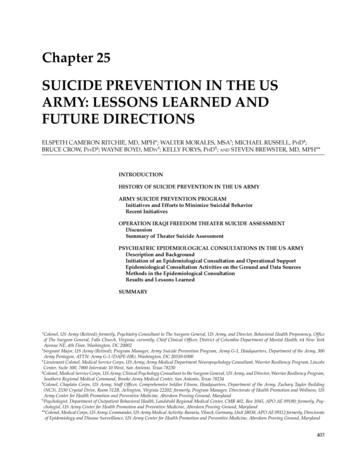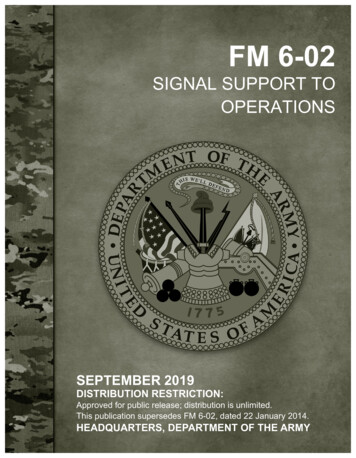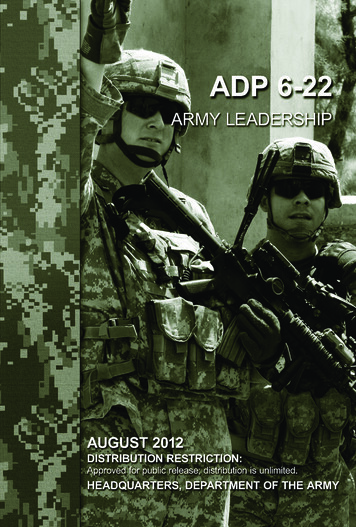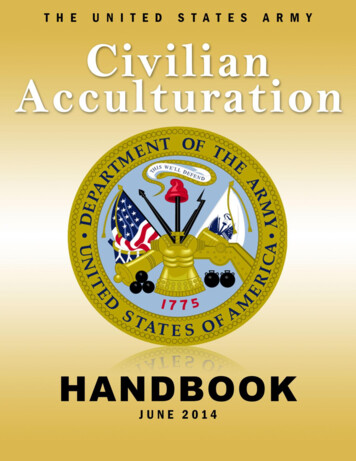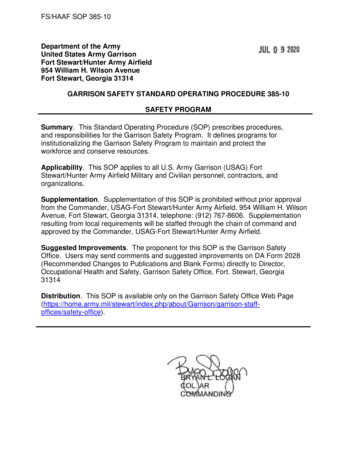
Transcription
FS/HAAF SOP 385-10Department of the ArmyUnited States Army GarrisonFort Stewart/Hunter Army Airfield954 William H. Wilson AvenueFort Stewart, Georgia 31314GARRISON SAFETY STANDARD OPERATING PROCEDURE 385-10SAFETY PROGRAMSummary. This Standard Operating Procedure (SOP) prescribes procedures,and responsibilities for the Garrison Safety Program. It defines programs forinstitutionalizing the Garrison Safety Program to maintain and protect theworkforce and conserve resources.Applicability. This SOP applies to all U.S. Army Garrison (USAG) FortStewart/Hunter Army Airfield Military and Civilian personnel, contractors, andorganizations.Supplementation. Supplementation of this SOP is prohibited without prior approvalfrom the Commander, USAG-Fort Stewart/Hunter Army Airfield, 954 William H. WilsonAvenue, Fort Stewart, Georgia 31314, telephone: (912) 767-8606. Supplementationresulting from local requirements will be staffed through the chain of command andapproved by the Commander, USAG-Fort Stewart/Hunter Army Airfield.Suggested Improvements. The proponent for this SOP is the Garrison SafetyOffice. Users may send comments and suggested improvements on DA Form 2028(Recommended Changes to Publications and Blank Forms) directly to Director,Occupational Health and Safety, Garrison Safety Office, Fort. Stewart, Georgia31314Distribution. This SOP is available only on the Garrison Safety Office Web AN L. LOGANCOL, ARCOMMANDING
FS/HAAF SOP 385-10Table of ContentsCHAPTERPARAGRAPHChapter 1: GeneralPurpose .1-1References .1-2Explanation of Abbreviations and Terms .1-3Records Management 1-4Garrison Commander or Manager 1-5Garrison Safety Manager .1-6Supervisors .1-7Contractors 1-8Contracting Officers .1-9PAGE444446888Chapter 2: OverviewObjectives .Organizational Alignment, Reporting, and Functions .Army Safety Program Functions and Key Mission Areas .2-12-22-391010Chapter 3: Administrative ProceduresRisk Management (RM) Policy Operational Procedures and Standards .Planning, Program Evaluations, Councils, and Committees .Common Levels of Support (CLS) .Safety Awards .3-13-23-33-43-51112121314Chapter 4: Types of SafetyAviation (Airfield) Safety Management Range Safety .Explosives Safety .Radiation Safety .Chemical Agent Safety .System Safety .Contracting Safety .Garrison Industrial Operation Safety Occupational Safety and Health Program (Workplace Safety) Public, Family, Off-Duty, Recreational, and Seasonal Safety 27Chapter 5: Prevention, Response, Investigation, and Reuse and ClosureTraining Requirements .5-1Motor Vehicle Accident Prevention .5-2Emergency Planning and Response .5-3Accident Investigation and Reporting .5-4Workplace Inspections .5-5Facility Reuse and Closure .5-62282829303131
FS/HAAF SOP 385-10AppendicesA. References .Page 33Figure ListFigure 2-1. IMCOM Safety Program Mission-Essential Program ElementsPage 11GlossaryPage 38TermsPage 423
FS/HAAF SOP 385-10Chapter 1Section 1General1-1. Purpose:This SOP prescribes procedures, and responsibilities for managing the GarrisonSafety Program. It provides Garrison-specific requirements to supplement the ArmySafety Program responsibilities defined in AR 385-10 (The Army Safety Program) andDA Pam 385-10 (Army Safety Program), and incorporates the requirements of theOccupational Safety and Health Act of 1970. This SOP will assist Garrison leadershipand military and Civilian employees in protecting the force, protecting againstaccidental loss, conserving resources, and establishing a proactive safety culture.The objective of the Garrison Safety Program is to institutionalize safety and riskmanagement processes in Garrison operations, systems, doctrine, and training. TheGarrison Safety Program is based on the key elements of leadership, managementcommitment, employee involvement, and continuous process improvement.1-2. References:Required and related publications and prescribed and referenced forms are listed inAppendix A.1-3. Explanation of Abbreviations and Terms:Abbreviations and terms used in this SOP are explained in the glossary.1-4. Records Management:Records created as a result of processes prescribed by this SOP will be identified,maintained, and disposed of according to AR 25-400-2 (The Army Records InformationManagement System (ARIMS)) and DA Pam 25-403 (Guide to Recordkeeping in theArmy). Record titles and descriptions are available on the ARIMS website(https://www.arims.army.mil).Section 2Responsibilities1-5. The Garrison Commander will:a. Oversee the implementation of the Garrison Safety Program and incorporatefunctions defined in AR 385-10 (Army Safety Program), Table 1-1.b. Ensure the Garrison Safety Program is adequately funded to meet programrequirements.4
FS/HAAF SOP 385-10c. Incorporate accident prevention performance standards in rating elements formilitary and Civilian subordinates.d. Ensure Class A, B, C, and D Army accidents involving Garrison personnel(Appropriated Funds personnel, Non-Appropriated fund personnel, and USAG Soldiers)or equipment are reported and processed using “ReportIt!” which is available athttps://reportit.safety.army.mil.e. Provide an accident briefing to the Commanding General (CG), InstallationManagement Command (IMCOM) on Class A accidents and other accidents involvingGarrison personnel, operations, or facilities as directed by Headquarters (HQ) IMCOM.f. Mandate workplace accidents involving Garrison personnel, operations, orfacilities are reported to the Garrison Safety Office for investigation and a follow-up.g. Ensure a safety action plan to correct identified deficiencies is implemented.h. Chair the Garrison Safety and Occupational Health Action Council (SOHAC).i. Serve as the chair of the Garrison Radiation Safety Committee or appoint adesignee.j. Promote Garrison safety by ensuring:(1) Coordination with the IMCOM Safety Manager for integration ofArmy, IMCOM, and applicable safety requirements into all operations, includingcontractor operations.(2) Approve proposed purchases of hazardous materials or personalprotective equipment (PPE) by designated Safety and Occupational Health (SOH),Industrial Hygiene (IH), or trained and qualified Unit Safety Officer (USO) personnel.Respirators and individual water treatment devices will be included. A list of locallyapproved items may be developed to minimize repeated SOH review of the same items.(3) Integrate Risk Management (RM) into all Garrison activities.(4) Conduct a systematic review of after-action, accident-investigation, and nearmiss reports and publication of lessons learned.(5) Submit nominations for safety awards for outstanding individuals and unitsaccording to AR 385-10, chapter 8, and DA Pam 385-10 (Army Safety Program),chapter 6. Award packets will be submitted to higher headquarters NLT 30 NOV eachyear.5
FS/HAAF SOP 385-10k. Ensure the following Garrison worker’s compensation functions are effectivelyimplemented:(1) Advise employees of rights and responsibilities under the InjuryCompensation Program. Compensation claim forms will be available for employees.(2) Support of the Safety, Health and Return to Employment (SHARE) (3) Restructure positions for employees who have been permanently or partiallydisabled because of a job-related injury or illness. The reasonable accommodationprovisions of 29 CFR 1614.203 (Federal Sector Equal Employment Opportunity) applyto the Injury Compensation Program.l. Ensure coordination of safety participation with the Installation MedicalActivity or other designated support organizations in the following occupational healthfunctions and programs:(1) Ergonomics, Hearing Conservation, or Industrial Hygiene Programs.(2) Integration of cross-functional processes between the SOH, IH, and Worker’sCompensation Programs.m. Execute core programs within the Sustainable Range Program (SRP), AR 35019.1-6. Garrison Safety Manager will:a. Advise the Garrison Commander on technical safety issues.b. Assist the installation staff, Garrison and tenant activities as required. SOHReports shall be submitted to higher HQ.c. Manage the Garrison Safety Program. Collect and brief safety metrics to thecommand including goals, milestones, and trends as a function of safety performance.Monitor compliance and track renewal, changes, or updates to the IMCOM SafetyProgram.d. Plan, develop, and submit a budget for the Garrison Safety Program in supportof the IMCOM Common Levels of Support (CLS) for safety.e. Train Garrison managers and supervisors, USOs, managers, and workers onpractical applications of the Army and IMCOM Safety Programs in accordance withapplicable regulations and directives.f. Develop and implement a standard safety inspection process that trackscorrective actions, trends, lessons learned, and follow-up actions.6
FS/HAAF SOP 385-10g. Provide input, as requested, for performance appraisals and position descriptionsto reflect appropriate safety standards and evaluation criteria for managers, supervisors,and workers.h. Advise contracting officers and Civilian personnel of the integration of SOHrequirements into contracts. Review contracts as applicable.i. Review and provide recommendations on the purchase of safety equipment.j. Implement, manage, review, and improve applicable Accident PreventionPrograms for Garrison personnel.k. Manage the Army Traffic Safety Training Program (ATSTP), includingmotorcycle safety rider courses, in coordination with HQ IMCOM.l. Facilitate the Installation SOHAC.m. Coordinate with IMCOM for assistance regarding Worker’s CompensationProgram issues.n. Design, implement, and evaluate a safety inspection program for Garrisonfacilities, operations, and personnel.o. Ensure that all Army accidents are reported via Report It!(https://reportit.safety.army.mil) and review reports submitted by supervisors andinvestigate accidents according to AR 385-10, chapter 3, and DA Pam 385-40 (ArmyAccident Investigations and Reporting). Ensure reports are accurate and complete.Analyze accident data to identify trends and develop and recommend countermeasures.p. Evaluate effectiveness of safety training for Garrison personnel.q. Train, monitor, and professionally develop Unit safety personnel.r. Oversee the Army Radiation Safety Program, IAW AR 385-10, chapter 7, and DAPam 385-24, to ensure proper procurement, licensing, receipt, inventory, maintenance,and/or disposal of radiation-producing sources or equipment as applicable.s. Manage the Garrison Workplace Safety Program.t. Coordinate with the Directorate of Plans, Training, Mobilization and Security(DPTMS), and Aviation Safety Officers assigned to aviation activities.u. Manage, oversee, and coordinate safety support related to range facilitiesincluding design, maintenance, and compatibility.7
FS/HAAF SOP 385-10v. Review, staff, coordinate, and recommend concurrence for the followingrequests to be forwarded through HQ IMCOM Safety Office for endorsement orapproval:(1) Deviations, exemptions, accuracy, and Certificates of Risk Acceptance(CORA) to Garrison workplace, explosives, and explosive site plans.(2) Deviations to range safety standards required by AR 385-63 (Range Safety)and DA Pam 385-63 (Range Safety).w. Prepare, review, approve, and ensure compliance, for explosive storagelicenses, subject to command limitations.x. Review military construction (MILCON) and other construction projects,maintenance, repair projects, Garrison service, and procurement contracts.y. Assist with the preparation and submission of explosive site plans andunexploded ordnance, chemical agent, and biological material remediation programs,as applicable.1-7. Garrison Supervisors will:a. Implement the Army Safety Program.b. Ensure employees follow SOH rules and regulations, including the use ofpersonal protective clothing and equipment.c. Implement and provide feedback on safety SOPs, training, and PPErequirements prior to performing work.d. Review and document job hazard analyses for work operations performed byassigned Garrison employees IAW DA Pam 385-30 (Conducting a Job HazardAnalysis).e. Use the Report It! system to report Army accidents. Report It! is available on theU.S. Army Combat Readiness Center Website at https://reportit.safety.army.mil. TheGarrison Safety Manager will serve as reviewer for accident reports and assistsupervisors in the proper use of the reporting tool.f. Report injuries and illnesses according to 29 CFR 1960, subpart I (Basic ProgramElements for Federal Employee Occupational Safety and Health Programs and RelatedMatters); Department of Defense Instruction (DODI) 6055.07, (Accident Investigation,Reporting and Recordkeeping); AR 385-10; and DA Pam 385-40.g. Evaluate and take actions to correct hazards reported by employees.8
FS/HAAF SOP 385-10h. Support the Accident Investigation Program. All accidents will be reported viaReport It!i. Request SOH review of purchased items such as PPE, tools, machinery, andoffice furniture unless reviews have already been performed.1-8. Contractors will comply with OSHA standards and Federal, State, DoD, Army,and local SOH requirements.1-9. Contracting Officers will:a. Ensure the contract safety requirements of AR 385-10, chapter 4, are included inthe following:(1) Service and supply contracts(2) Construction contracts(3) Explosives and chemical facilities construction, work, and services(4) Biological research, development, test, and evaluation facilities construction,work, and services(5) Radiographic facilities construction, work, and servicesb. Coordinate with the Safety Manager for the command or activity to evaluate andensure contractor compliance with the SOH requirements in contracts.c. Notify contractors verbally, requesting corrective action when noncompliance ofrequirements or conditions poses serious or imminent danger to the individual’s healthor safety. Notify contractors in writing if problem persists.d. Appoint quality assurance representative points of contact (POCs) at Garrisonlevels to execute safety responsibilities.Chapter 2Overview2-1. Objectives:a. The Garrison Safety Program will ensure safe work practices and operations inorder to reduce costs associated with accidents and incidents, and increase operationalefficiencies. Garrison personnel will integrate safety into work processes throughmanagement and worker involvement with planned and authorized work activity.9
FS/HAAF SOP 385-10b. Implement the required safety program and mission-essential program elementsaccording to AR 385-10, Table 1-1, and DA Pam 385-10, Chapter 3 and Appendix J.c. Incorporate DoD and Army RM processes, and other industry best practices intothe Garrison Safety Program.d. The core functions of the Garrison Safety Program include:(1) Safety and Occupational Health program management(2) Education, training and promotion(3) Inspections and assessments(4) Mishap and near-miss investigation reporting and analysis(5) Hazard analysis and countermeasures as outlined in DA Pam 385-10,Figure 3-1.e. Standard core safety structure shown in Figure 2-1 lists the safety programelements applicable to the Garrison.f. Garrison personnel (military and Civilian) will take appropriate actions to keepthemselves, fellow employees, and third-party personnel safe and healthy. Performduties and work activities according to applicable safety and occupational healthstandards.2-2. Organizational Alignment, Reporting, and Functions:a. The Garrison Safety Office is an installation support office. The Garrison SafetyManager will report directly to the Garrison Commander. The reporting chain does notinclude safety assets belonging to tenant/mission units or installation staff.b. The Senior Commander may elect to co-locate the Garrison and Mission SafetyOffices. Where co-located, the Senior Commander will designate a Senior SafetyDirector in compliance with Federal safety requirements to direct and synchronizeGarrison and Mission safety programs and initiatives. The reporting chains for theGarrison and Mission Safety Offices will remain separate.c. The objective of maintaining a proper reporting chain is to ensure theCommander is informed and involved with safety initiatives affecting employee safetyand mission readiness. Areas to be coordinated are related to safety procurementrequirements, mishap reporting, and other programmatic issues. The IMCOM SafetyDirector coordinates safety issues with the HQ IMCOM Command.d. Garrison Safety Managers are required to manage and direct core safetyprograms identified in (Figure 2-1, below), AR 385-10, DA Pam 385-10, and related10
FS/HAAF SOP 385-10documents.2-3. Army Safety Program Functions and Key Mission Areas:a. The Garrison Safety Program will focus on key Garrison-mission areas such asGarrison safety program management, supporting the force, and supporting Garrisonand industrial bases.b. Figure 2-1 outlines the safety program elements, which are aligned with keyGarrison safety mission areas that involve activities requiring specific technical safetyfocus to ensure safe operations. The mission-essential program elements incorporatethe required technical scope for a Garrison Safety Program. The level of core functionsand program elements for implementation may vary and can be tailored to Garrisonneeds. Range safety is a mission-essential program element of the Garrison SafetyProgram.Figure 2-1. Garrison Safety Program Mission-Essential Program Elements11
FS/HAAF SOP 385-10Chapter 3Administrative Procedures3-1. Risk Management (RM) Policy:a. The concepts and principles in ATP 5-19 (Risk Management) will be embracedat every level within the Garrison. RM is applied to training and operations at all levelsof the command. Commanders will not accept unnecessary risk. Directorates willperform risk assessments and provide copies to the Garrison Safety Office prior toscheduled events.b. Commanders are required to establish local approval authority for acceptance ofresidual risk. However, this local policy must not be less stringent than:(1) Extremely High: First General Officer (GO) or Senior Executive Service(SES)(2) High: First O6 or GS-15(3) Moderate: First 05 or GS-14(4) Low: First 04 or GS-133-2 Operational Procedures and Standards:a. Operational Standards.(1) Garrison Commanders will ensure that their local safety policies comply withAR 385-10.(2) Standards established by the Department of Labor pursuant to Public Law91–596, sections 6 and 19, and the OSH Act of 1970 are adopted as Army safetystandards and will be complied within applicable Army workplaces.(3) The US Army Corps of Engineer’s Safety and Occupational Health (SOH)requirements manual, EM 385–1–1 (Safety and Health Requirements), incorporates 29CFR 1926 (Safety and Health Regulations for Construction) and applies to Armyconstruction operations.(4) Commanders will apply OSHA and other non-DA regulatory or consensusSOH standards to military equipment, systems, operations, or workplaces.(5) Special operations, such as munitions facilities, are subject to mandatorysafety standards and rules that derive from different regulatory agencies. Theapplication of special functional standards does not exempt workplaces from other safetycriteria. Compliance with publications describing job safety requirements is mandatoryfor this type of workplace.12
FS/HAAF SOP 385-10b. Operational Procedures(1) The Senior Commander will resolve safety standard conflicts. However,unresolved issues will be referred to the next higher command level for adjudication.(2) The Senior Commander or Garrison Commander will resolve conflictsbetween Garrison and mission safety functions concerning safety standards/policies inDoDI 6055.1 (DOD Safety and Occupational Health (SOH) Program), AR 385-10.3-3. Planning Program Evaluations, Councils, and Committees:a. Garrison personnel will implement the Garrison Safety Program IAW AR 385-10.b. Planning. The Garrison will develop written plans and objectives to guide theexecution of the safety programs.(1) The Garrison Safety Manager will develop fiscal year (FY) objectivesannually to target top-loss areas and support the objectives of the Army Safety Office.The Garrison safety objectives will be distributed to all Garrison directorates forincorporation into their planning.(2) The Garrison Safety Office will develop annual safety action plans thatinclude key safety objectives, metrics, performance targets, and resource requirements.Garrison safety action plans will target top-loss areas affecting the Garrison orinstallation and support higher-level safety objectives. The Garrison Commander willreview the safety program on a periodic basis sufficient to effect changes and/orimplement updates.c. Program Evaluations. Garrison Safety Program evaluations provide thecommand a current assessment of the effectiveness of the safety program. Evaluationsidentify systemic problems to be addressed at HQ IMCOM, assess RM integration, andensure compliance with applicable standards and policies.(1) The Garrison Safety Manager will ensure subordinate SOH programs areevaluated annually using approved checklists. IMCOM Form 7 – OrganizationalInspection Program Checklist contains an example of a program-evaluation checklist.Garrisons may develop local checklists to address specific concerns.(2) The annual evaluation program schedule is published by the Garrison SafetyOffice at the beginning of the FY. Submission of potential mission conflicts or requestsfor changes to a scheduled evaluation will be directed through the Garrison SafetyManager to the Garrison Commander in writing.(3) The US Army Public Health Command Center may evaluate occupationaland environmental health elements during the annual evaluation. Garrison13
FS/HAAF SOP 385-10Commanders will receive a single report containing consolidated findings andrecommendations.(4) The Garrison Safety Manager will provide a written report of the findings aftereach evaluation to the Garrison Commander. Responses shall be specific and specifythe corrective actions taken, including the personnel responsible for the correctiveaction toward the deficiencies and the date of completion.d. The Commanders of separate detachments, companies, and above willestablish a Soldier and DA Civilian Employee Safety Committee IAW AR 385-10,Paragraph 2-24.(1) Prepare and maintain records according to Army and OSHA requirements.(2) Provide copies of the minutes to the IMCOM Safety Director and post foremployee awareness.3-4. Common Levels of Support (CLS): CLS guidelines and performance metricsensure the delivery of required safety services to personnel, and promote the equitabledistribution of safety resources throughout IMCOM. These guidelines and metrics aresubject to review and update by HQ, IMCOM with periodic publication of changes. TheGarrison Safety Manager will ensure the metrics/goals are met successfully.3-5. Safety Awards:a. The Garrison will submit, through HQ IMCOM, recommendations for Army SafetyAwards IAW DA Pam 385-10. The IMCOM Safety Director will establish amultidisciplinary award review panel comprised of IMCOM military and civilian personnel.The panel will review award nominations and submit approved nominations to the CG,IMCOM for endorsement. CG, IMCOM will forward nominations and endorsements toHQDA.b. The Garrison will develop safety awards at the local level to readily recognizeindividual and Garrison safety accomplishments.Chapter 4Safety Requirements4-1. Aviation (Airfield) Safety Management:a. The Garrison Safety Office’s responsibilities are limited to airfield and groundsafety issues. Aviation units using the facilities are responsible for safety requirementsassociated with operational and flight activities. Garrison airfield safety managementwill follow guidelines in AR 95-2, AR 385-10, and DA Pam 385-90.14
FS/HAAF SOP 385-10b. The Garrison Safety Manager, in conjunction with the Garrison G-3 AirfieldSafety Program Manager, will:(1) Develop and implement a written Garrison Airfield/Heliport Safety Programthat complies with the requirements in AR 95-2, AR 385-10, and DA Pam 385-90.(2) Develop and disseminate airfield safety lessons learned and best practicesfor the airfield/heliport safety community.(3) Assess the adequacy of airfield safety program standards and developcountermeasures.(4) Analyze all aspects of the airfield safety program through airfield QualityAssurance Evaluations (QAE).(5) Assist Airfield Safety Program Manager by providing technical andadministrative guidance regarding all functions of airfield/heliport safety.c. The Garrison Commander will:(1) Maintain one current authorized full-time GS-0018 position for a qualifiedAirfield Safety Program Manager assigned as a primary duty at the airfield and rated bythe airfield manager. An assistant airfield safety program manager may be authorizedat auxiliary/satellite airfields/heliports based on duties, responsibilities, location and levelof effort.(2) Effectively manage risk to minimize the accidental loss of airfield/heliportpersonnel and equipment.(3) Ensure coordination with tenant aviation units concerning airfield and aviationsafety responsibilities, functions, and funding.(4) Comply with applicable policies regarding airfield and ground safety per AR95-2, AR 385-10, and DA Pam 385-90.(5) Establish funding to support training for the Airfield Safety Program Manager.(6) Provide funding for promotional items to the Airfield/Heliport Safety Office.(7) Incorporate accident prevention performance standards in rating elements forcivilian subordinates at the airfield/heliport.(8) Follow the IMCOM Regulation 385-10 on the responsibilities of the GarrisonCommander on accident reporting when using the Loss Reporting Automation System(LRAS).15
FS/HAAF SOP 385-10d. The Airfield Safety Officer will:(1) As their primary duty, advise and assist the Airfield Manager and staff on allairfield/heliport safety matters, including:(a) Developing airfield/heliport safety programs and policies IAW AR 95-2, AR385-10, and DA Pam 385-90.(b) Developing safety goals, objectives, and priorities and integrating them intoappropriate training guidance based upon identification of the most probable and severetypes of accidents expected and the most likely reasons (hazards) for these accidents.(c) Developing corrective actions/control options for command selection.(d) Developing a Newcomer’s Safety Briefing where all hazards of the workplaceare identified and discussed. Training airfield personnel on flight-line driving and airfieldsafety awareness.(e) Ensuring the airfield safety functional files are maintained IAW AR 25-400-2.(2) Advise the Airfield Manager when a below-standard status that affectsairfield/heliport safety is detected in any functional area.(3) Advise and assist in developing the Airfield Manager’s training assessmentbased upon a safety assessment of airfield/heliport functional areas using diagnostictools and programs administered or monitored by the Airfield Safety Program Manager.(4) Lead or assist (as appropriate) in the response to any ground or aviationaccidents and incidents occurring on the airfield/heliport.4-2. Range Safety:a. Range safety ensures range facilities, lands, and associated infrastructure onthe Garrison provides a safe environment for military training.b. The Garrison Safety Manager will:(1) Develop and implement a written Range Safety Program that complies withthe requirements in AR 350-19, AR 385-10, DA PAM 385-10, and DA Pam 385-63.(2) Develop and disseminate range safety lessons learned.(3) Assess the adequacy of range-safety standards and developcountermeasures.16
FS/HAAF SOP 385-10(4) Assist the Range Safety Program by using units and agencies for riskmanagement of range and live-fire operations.c. Garrison Commander will:(1) Execute the safety responsibilities IAW AR 75-1, AR 350-19, AR 385-10,AR 385-63, DA Pam 385-63, and DA Pam 385-64.(2) Designate a Range Control Officer (RCO) and require RM implementationand documentation for all range operations and training.(3) Serve as the approval authority on requests for deviations to range safetystandards, unless this is a Senior Command responsibility.d. RCOs will:(1) Be responsible for the operation of the Range Operations organization duringthe implementation of the Range Safety Program. Execute responsibilities assigned inAR 385-63 and DA Pam 385-63.(2) Maintain coordination with the Garrison Safety Manager and tenant safetymanagers on matters relating to range and live-fire operations.(3) Develop a range-safety directive and ensure ranges have safety SOPs.(4) Develop and implement an on and off post range safety educational programin coordination with the Garrison Safety Manager, Public Affairs Office (PAO), QualityAssurance Specialist Ammunition Surveillance (QASAS), Provost Marshal, and localExplosive Ordnance Disposal (EOD) unit commander.(5) Ensure selected Range Operations personnel receive range safety training.A member of the Range Operations Organization will be a graduate of the Army RangeSafety Course (intermediate level). A member of the Range Operations Organizationand personnel will be unexploded ordnance (UXO)-recognition qualified through EODtraining when the recognition training program is implemented.(6) Initiate or review requests for deviations to range safety standa
Record titles and descriptions are available on the ARIMS website (https://www.arims.army.mil). Section 2 Responsibilities 1-5. The Garrison Commander will: a. Oversee the implementation of the Garrison Safety Program and incorporate functions defined in AR 385-10 (Army Safety Program), Table 1-1.






